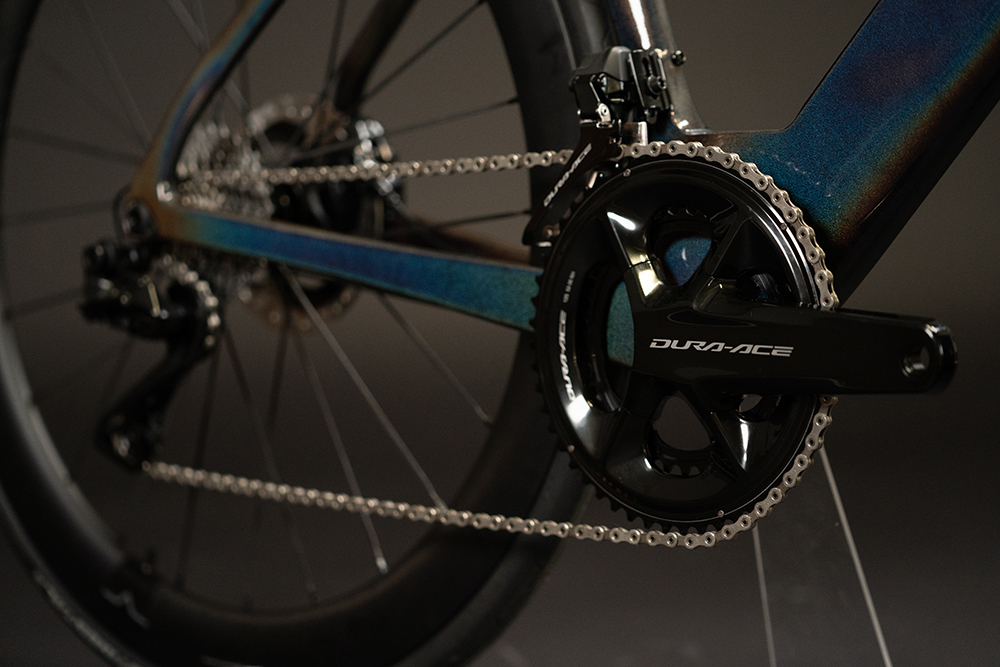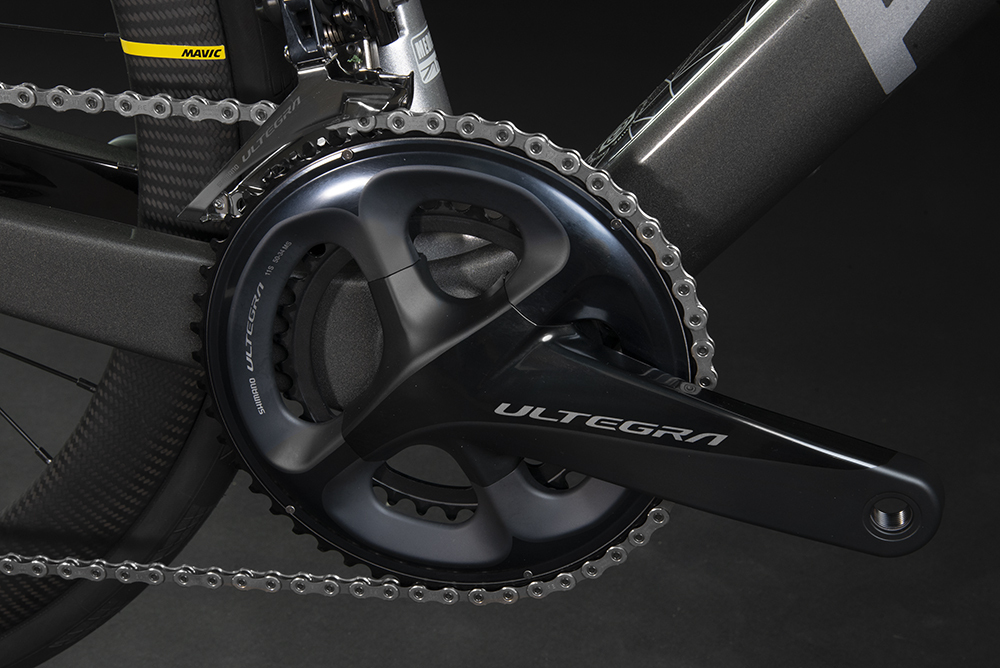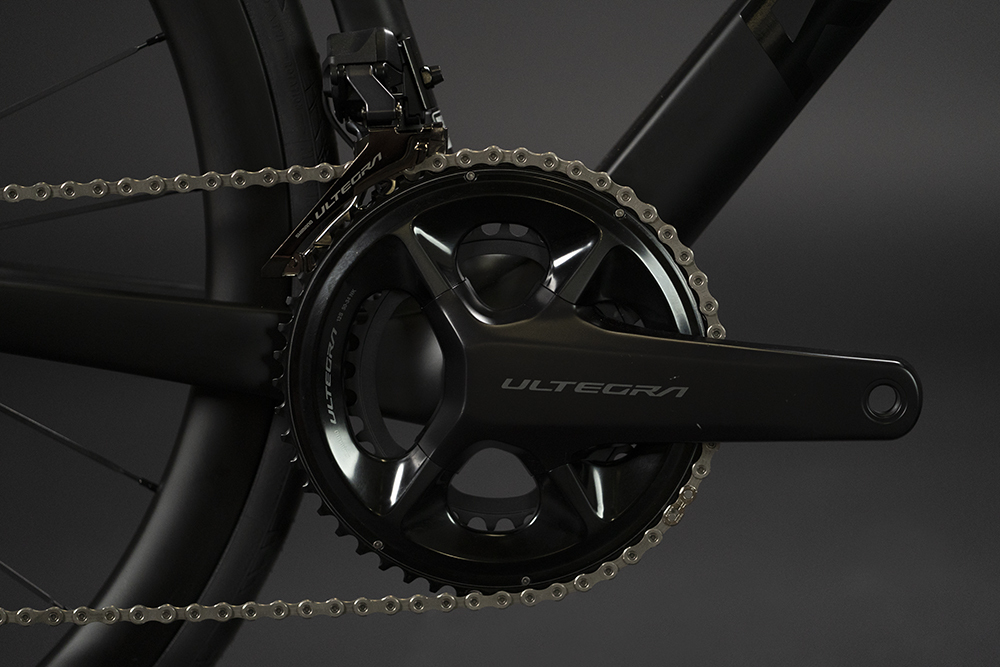
Picking the right gears has a dramatic effect on how your bike rides and how much (or little) you wish to suffer when the road heads upwards. Our gearing explained guide will hopefully make you a little more gear savvy when it comes to your bikes spinny bits.
GEARING EXPLAINED
We can well understand the confusion when it comes to deciding what gear ratios your new bike should have. It's easy enough for experienced cyclists to become bamboozled by gearing options let alone anyone looking to take up cycling for the first time. Especially when faced with options such as 10, 11, or 12 speed and cassette ratios of anything between 11-28 and 11-50.
So we've put together this gearing explained beginner's guide to hopefully help you decide which is the right fit for you.
So, when we refer to gearing, what specifically are we talking about?
Simply put, it's the chainset at the front and the cassette (also referred to by some as sprockets or cogs) at the rear. More specifically the number of teeth each component has. The general rule of thumb is that the more teeth a chainring has, the harder it is to pedal. However, the opposite is true for the rear cassette, the more teeth there are, the easier it is to pedal.
Therefore, if you wanted to make ascents easier you would want smaller chainrings at the front and larger sprockets at the rear. With us so far?
Now for the nitty-gritty. Just how does one go about selecting one option over another. And how does your selection affect how the bike performs?
Chainrings

A chainset will typically consist of 1, 2, or rarely 3 chainrings. Otherwise referred to as One by, Double and Triple respectively.
To put it as simply as possible, the smaller these are then the easier it will be to spin the pedals.
Most bikes will come fitted as standard with chainsets that have 1 or 2 chainrings. If it is a double chainset there will be 2 chainrings, an inner and outer. The inner is always by virtue of its small number of teeth the climbing ring. The larger diameter outer chainring is better suited to flatter terrain and descending.
Ribble is renowned for its bike customisation options, which means that virtually every bike in the range is fully customisable. You can choose whatever chainring sizes and cassette ratios you need to suit your preferred terrain or riding style.
34/50

You may see or hear this referred to as 'compact'. Both the inner and outer chainrings are quite small, which makes pedaling easier. This comes in especially handy when you hit the climbs. The 34-50 ratio chainset has found great popularity among novice cyclists or seasoned roadies looking for more assistance on the climbs. So much so, you will now see this chainring ratio is the default option on the majorty of the endurance bikes on the market today.
However, this climbing assistance comes with a trade-off. The relatively small diameter outer ring will cause you to 'spin out' more quickly when descending our going full gas on the flats (if you're fast and fit enough). Spinning out is when you run out of gears and your legs spin like the clappers but with little effect to your forward progress.
36/52 - 34/53

Shimano 12-speed groupsets now include a semi-compact 34/53 ratio.
Known as ‘semi-compact’ this is an intermediate option for riders who still want help on the hills but desire more speed on the flats and descents. Rather than the 34/50 of compact, you now get 36/52 or 34/53 chainrings.
39/53

Ok, so it's not strictly 39/53, but it is so very pretty!
Back in the latter part of the 20th century, almost every new bike would arrive with a ratio identical or similar to this. It was for a time the standard 'race' setup and dates back to a time when you bought a bike that simply came with double or triple gearing. Today's racers will still use something very similar, albeit with a slightly larger outer ring. This ratio is fast on the flat but offers little assistance on the climbs. It is, therefore, only the supremely fit or dedicated racers who use this.
1x Single Chainring

The lack of a front derailleur adds simplicity and greater chain security over rough terrain.
The relatively new kid on the block is the single ring chainset. Or 1x as it is referred to in the cycle industry. 1x isn't actually a new concept. In fact, it's been used in the MTB sector for a number of years. Its transition to the drop-bar bike sector, however, has been surprisingly slow considering the advantages it offers in certain scenarios.
Let's take the Gravel Bike boom, for instance. The more difficult terrain encountered when riding off-road demands a lower gear range than you would typically find on any road bike. Enter the 1x system. Its popularity now means that nearly all gravel and all-road bikes come with it as standard.
With only a single chainring to worry about, you don't need a front derailleur. By removing this you instantly eliminate any possibility of a front end chain jam. When riding off-road mud and debris had a tendency to clog up the derailleur which could force the chain to unship when shifting.
With the 1x system you can expect to see chainrings as small as 30t or as large as 44t specced. This will depend entirely upon the model of the groupset.
Cassettes

A wide range cassette, note the increase in cog size. The closer to the top, the easier it is to pedal.
A cassette is a collection of cogs that sits on the rear hub and provides a select gear range for every riding discipline. In direct contrast to the chainrings, the larger the sprocket is, the easier it is to pedal. Large sprockets are more advantageous when climbing.
The groupset that a bike is supplied with will determine whether the cassette will have anything between 8 and 13 sprockets. Entry-level groupsets will typically have between 8-10 sprockets, whereas mid to top-tier will have between 11 and 13.
You, therefore, need to select an appropriate cassette ratio for the terrain you expect to ride most often. For most assistance on the ascents when riding on the road an 11-32 to 11-36 may prove most beneficial.
Closer ratio cassettes such as 11/25, 11/28 or 11/30 are better for riders with a high level of fitness or who prefer flatter terrain.
1x systems are equipped with cassettes that have a much wider spread - anything between 11-42 and 10-50 at the norm.
Gear Ratios
Climbers gearing - 34/50 with 11/32 or 11/34 Cassette
What we here at Ribble refer to as a 'climbers' ratio. It's what we recommend for beginners or existing road riders who want plenty of assistance on the climbs. With both a small and large chainring at the front, there's no need for a massive cassette at the rear.
The advantage of this is that when you change gear the jumps between each individual gear are smaller. The smaller the steps between gears are, the smoother the action is when shifting from one sprocket to the next. A smoother shift results in less interruption of your pedaling rhythm (cadence). This is more pronounced with 1x systems due to their much bigger sprockets.
Semi-Compact 36/52 with 11/25 to 11/34
Amateur racers and riders with a decent level of fitness may benefit from this setup. It still offers some assistance on the climbs thanks to its 36t inner ring. However, it's the 52 tooth outer chainring that anyone opting for this setup really desires. This setup offers the following benefits;
- The gap between gears is relatively small. Ideally, you want to keep this number as small as possible. The reason for this is to avoid loss of pedaling rhythm when changing gear. A loss of rhythm will also affect power output making it less efficient. Therefore, opting for a smaller spaced cassette like an 11/25 or 11/28 avoids this jump when changing gear.
- The gears do not 'spin out' as fast when descending. Spinning out is when you descend at such a velocity that you can no longer pedal. Sure you can spin the pedals but there is no traction on the chain. A large chainring at the front means that you can pedal for longer before losing chain traction.
- Specifying larger chainrings and/or closer cassette ratios also makes the bike faster on the flat.
Single Chainrings
The gearing loadout of a bike will depend entirely upon what type of bike you go for and what groupset it comes fitted with. A hybrid style of bike will often have a chainring as small as a 32t at the front and a road ratio cassette of 11-32 to 11-36 at the rear.
Allroad or gravel bikes tend to have a larger chainring of approximately 40 to 44t. This is then combined with an MTB ratio cassette of anything between 11-42 and 10-50t. In reality, the gear range will be markedly similar and you are less likely to be offered a choice of gearing.
We hope this guide helps you gain an understanding of what to choose when buying a new bike. If, however you still need assistance then please do not hesitate to get in touch.
If you are in the market for a drop-bar bike, which should you choose? In our guide, we compare all-road bikes to gravel bikes and endurance bikes to help you decide.
Looking to take up cycling? Check out our guide for the answers to most of the usual rookie questions.
Looking to get fit or save some money. Find out why an e-bike could just be the solution that you are looking for. Click here to find out more.